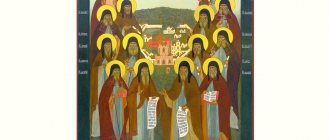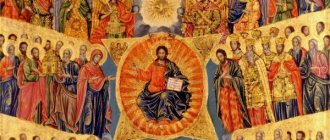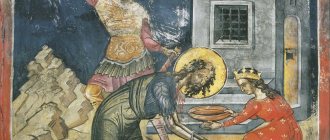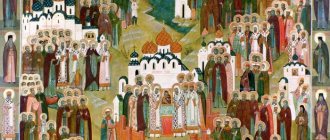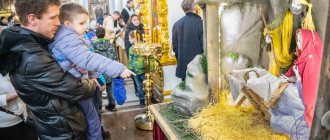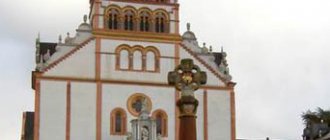| Second coming. Greece. Around 1700. Wood, gesso, tempera. Size - 34.5 x 27 cm. Private collection. |
All Saints Sunday
is the celebration of the Orthodox Church in honor of all saints. Celebrated on the 1st week after Pentecost
Continuing the celebration of Pentecost, when the descent of the Holy Spirit took place on the Apostles, the Sunday of All Saints recalls the entire multitude of saints who have shone and who should shine with the grace of the Holy Spirit throughout the world from Adam until the Second Coming of Christ.
The appearance of the holiday
The emergence of a common church memory of all martyrs, or all saints, occurred in the Eastern part of the Roman Empire no later than the end or beginning of the century. In the sermon of St. John Chrysostom in memory of “all the saints who suffered throughout the world,” it is reported that this holiday is celebrated a week after the Feast of Pentecost [1]. It was this custom that eventually spread throughout the Orthodox Church.
In Syria of the same era, this holiday also existed, but was celebrated at a different time. Thus, among the hymns of St. Ephraim the Syrian there are indications of the celebration of the memory of all saints on May 13 [2], and the Syriac Lectionary of 411 indicates this memory on the Friday after Easter [3].
In the Georgian translation of the Jerusalem Lectionary, reflecting the practice of the 7th century, the memory of all martyrs is indicated on January 22, followed at the liturgy: troparion of the 4th tone “Rejoice, martyrs of the Lord,” reading (prokeimenon from Ps 115, Proverbs 29, 2-6 , Isa. 65, 13-18, Hebrews 12, 1-11, alleluia with a verse from Ps 88, John 15, 20-16. 5a), troparion of the 2nd tone for the washing of hands “The original institutions,” troparion 4 -th voice for the transfer of Gifts “Sacrifice for you.” In addition, April 16 in this monument is about without specifying the sequence [4].
In the Western lands of the Roman Empire, the celebration of May 13, mentioned by St. Ephraim the Syrian, was also known. It was on May 13, 609 or 610 that Pope Boniface IV consecrated the former Pantheon in Rome as a temple in the name of the Blessed Virgin Mary and all the martyrs, after which this event was celebrated in the Western Church. In the first half of the 8th century, Pope Gregory III consecrated one of the chapels of St. Peter's Basilica in the name of All Saints and established an annual commemoration of this event on November 1, and a century later, Pope Gregory IV officially approved the feast of All Saints in the Western Church on this day. On October 31, on the eve of the holiday, fasting was supposed [5].
All Saints' Day. All Saints Cathedral
All Saints' Day or All Saints' Week is celebrated on the first Sunday (week) after the Feast of the Holy Trinity.
History of the Feast of All Saints Orthodox holiday All Saints Day Divine service on the Feast of All Saints Who are the saints Prayers to All Saints Akathist on the Feast of All Saints Day The Greatness of All Saints Video
HISTORY OF ALL SAINTS DAY
In the 4th century, the first mentions of this holiday began to appear. In the sermon of St. John Chrysostom (IV century), he glorifies “all the saints who suffered throughout the world” and points out a special day for their veneration. St. Petersburg also mentions this holiday in his hymns. Ephraim the Syrian (IV century).
Around the 5th century, the celebration in honor of All Saints began to be celebrated on the first Sunday after Trinity; later this holiday was officially assigned to this date by the Church.
ALL SAINTS DAY
The Church considers the main idea of this day to be the glorification of all the Saints, who are our intercessors before God and helpers in prayers to the Lord throughout our lives. We often turn to one or another Saint and ask them to help pray to the Lord for us, and Saints often respond to these requests, because they see our efforts in finding our spiritual path, in forgiveness and repentance.
It is no coincidence that All Saints' Day is celebrated immediately after Trinity. After all, Trinity is considered the Birthday of the Church and, like a small sprout planted in the ground, She blossomed in the person of the holy martyrs and confessors, saints, saints and holy fools.
None of these people were born saints. They were not sinless, they all had some sins, but the most important thing is to realize them and sincerely repent. Church canons warn the Orthodox that saints cannot be considered sinless. The Gospel says that even sinners enter heaven. To the right of the crucified Savior, a thief hung on the cross, who in the last minutes of his life repented to God and asked Jesus Christ:
“Remember me, Lord, when You come in Your Kingdom”
In this short sentence one could feel faith in Jesus, in His Divinity and the thief’s readiness to repent. She turned out to be sincere, otherwise this man would not have gone to heaven.
People came to their holiness in different ways, but the result was God's grace, which, according to St. John of Damascus, made them “pure dwellings of God.”
God's grace comes with the Holy Spirit, so people who prayed earnestly to the Lord and worked to "acquire" the Holy Spirit were strong in their faith. They were given a lot, but this gift of God was honestly “earned” by them and they did not “keep” this gift to themselves; with God’s help they helped people.
At a time when Rus' was conquered by the Mongol-Tatars, Holy Prince Alexander Nevsky visited the Horde more than once, all the time softening the Tatar Khan with his meekness. Thus, he practically saved Rus' from the extermination of Christianity by the Tatars; the invaders practically did not touch Orthodox churches and did not force our people to worship their gods. The revered Russian Saint, Reverend Sergius of Radonezh, more than once came to the princes and asked them for mercy in the form of relief for his peasants, and it was not surprising that the Saint’s requests were fulfilled, because he was strong in the Holy Spirit.
It is unknown how many Saints there are in Christianity. The feat of many people will remain unknown to people. Only God knows about this. He knows everything - about the deaths for faith in Christ, about the torment, about the work of ascetic monks who lived in difficult conditions, renouncing the world, and prayed for us people before the Lord.
After a godless time, the exploits of many thousands of ordinary people who ended up in Soviet camps for their faith became known. These people “only” preached the Gospel, love for God and people, honesty and decency in their lives, and not Marxism-Leninism. While tortured, they were tempted with freedom for signing on a piece of paper, which stated that there is no God. At the cost of their health or even their lives, they did not renounce God. These are real Saints! But in our understanding, they were ordinary people, they also went to shops, studied, worked, lived a simple life, these people lived quite recently and there are still those who saw them, who talked to them. It turns out that God's grace does not go back to the early or middle ages, it is very close to us. To be closer to God, it is necessary, as with everything in life, to make an effort, as did those people whose memory is honored on All Saints’ Day, who acquired the Holy Spirit and found the anointing of grace.
All Saints' Day is not a holiday in the sense that we perceive the word. This, to be more precise, is veneration and thanksgiving to them, pure and bright people who worked miracles for the glory of God. Who did not spare their lives for the glory of Christ, won the love and respect of people.
We are all under someone's protection and patronage; each person at baptism received a name in honor of some saint. It is very useful to read about your patron, how he lived, why he became a saint. Perhaps his example will help us become at least a little like him, improve our lives and learn to live the way your patron saint did.
In his sermon on All Saints' Day, Metropolitan Anthony of Sourozh said:
“If we want to give glory to the saints, glorify our saint, justify that this name has been entrusted to us, we must learn to live as he lived, as Christ lived, as we are called to live. Otherwise, every praise that we utter to a saint will someday be a reproach to us: he knew - and did not do it ... "
SERVICE ON ALL SAINTS' DAY
On Sunday, at the morning service, the eleven Gospels are read, telling about the resurrection of Christ. And at the evening Sunday service, excerpts from the Old Testament are read to the Glory of the Saints.
At the morning service the next day, Monday, a liturgy is held, at which the Gospel of Matthew and the Epistle to the Romans are read (during the Easter period, the Acts of the Holy Apostles and the Gospel of John were read).
On the same day, Orthodox Christians begin the Apostolic (Petrov) Fast.
WHO ARE THE SAINTS
In our prayers we turn to the Lord God, to His Most Pure Mother, to the Holy Angels and Holy People.
The Mother of God stands above all the Saints, she is closest to God. Angels are “messengers” from God, disembodied spirits who carry out His will. The saints of God are holy people who pleased God with their righteous life on earth. They pray to God for us and help us. Prophets are saints who lived before the coming of Jesus Christ and predicted the future, mainly about the Savior. The apostles are disciples of Jesus Christ, after the descent of the Holy Spirit on them, they preached the Christian faith throughout all countries. At first there were twelve apostles closest to the Lord, and then seventy more were called. Peter and Paul are the Supreme Apostles; they worked more than others in spreading Christianity. Matthew, Mark, Luke and John the Evangelist are the Evangelists who wrote about the life of Jesus Christ. Equal to the Apostles are saints who, like the apostles, spread the faith of Christ on Earth (the blessed kings Constantine and Helen, the blessed Holy Prince Vladimir). Martyrs - accepted cruel torment or death for the faith of Christ. Confessors are saints who died peacefully later, after suffering torment. Great martyrs are saints who died after severe suffering (Holy Great Martyr George (the Victorious), Holy Great Martyrs Barbara, Catherine). Saints are bishops or bishops who pleased God with their righteous lives (St. Nicholas the Wonderworker, St. Alexy, Metropolitan of Moscow). Hieromartyrs are saints who suffered torment for Christ. Ecumenical teachers are teachers of the entire Christian Church (Saints Basil the Great, Gregory the Theologian, John Chrysostom). Reverends are righteous people who have retired from worldly life and observed a vow of celibacy, who have pleased God. They mostly lived in deserts and monasteries (Sergius of Radonezh, Seraphim of Sarov). Reverend martyrs are saints who suffered torment for Christ. The righteous lived like us in the world, were family people and led a righteous life pleasing to God (Righteous Saints Joachim and Anna). Unmercenaries - they healed people without any payment, cured physical and mental illnesses (healer Panteleimon, Cosma and Damian). Fools for Christ's sake are people who, for the sake of Christ, show the world strange actions, but in fact are filled with deep wisdom. They are also called blessed (Xenia of Petersburg).
GREATNESS
We magnify you, holy passion-bearers, and honor your honest sufferings, which you naturally endured for Christ.
VIDEO
Icon of the Mother of God Burning Bush
Share:
Worship and customs
In the cathedral worship of Constantinople of the 12th century, according to the Typikon of the Great Church, the Sunday of All Saints was a holiday: on Saturday at Vespers, proverbs were read (Isa. 43, 9-14a, Pres. 3, 1-9; 5, 15-6. 3b), after Vespers, pannikhis was performed; at vespers; at Ps 50 of Matins and at the entrance of the Liturgy, the Typikon indicates the troparion to all the saints in the 4th tone, “Who is Thy martyr in all the world” (“Τῶν ἐν ὅλῳ τῷ κόσμῳ μαρτύρων σου”). Liturgy readings: Prokeimenon from Ps 15, Heb. 11, 33-12. 2a, an alleluia with a verse from Ps 33, Matt. 10, 32-33, 37-38, 19. 27-30, involved Ps. 32, 1. For the Sunday of All Saints, the Typikon of the Great Church also indicates the accompanying memories: on the Saturday before - the memory of the Most Holy Theotokos and Her parents Joachim and Anna, on the Wednesday after - the Council of the Most Holy Theotokos [6].
In the post-iconoclast Studite and Jerusalem monastic rules, the service of the Sunday of All Saints has the same readings as in the Typikon of the Great Church, supplemented by a number of chants. In different editions of these charters, right up to modern printed editions of the Jerusalem Typikon, this service is stated in generally the same way. On this day, 2 sequences are combined: Sunday and All Saints (the sequence of an ordinary saint is sung at Compline or on another day). The service regulations are the same as when the memory of the great saint coincides with Sunday, but without the singing of the polyeleos (and the chosen psalm with magnification) at matins. The Sunday of All Saints has a special significance in the annual cycle of worship: from this day the period of singing the Triodion ends and the period of singing the Octoechos begins; The Sunday of All Saints opens with a cycle of reading the 11 Sunday morning Gospels; From Monday after this week, the Gospel of Matthew is read at the liturgy.
The hymnographic sequence given in modern liturgical books includes the troparion of the 4th tone “Thy martyr in all the world” (“Τῶν ἐν ὅλῳ τῷ κόσμῳ μαρτύρων σου”), kontakion of the plagal 4th, i.e. e. 8th, tone “Like the firstfruits of nature, the Educator of creation” (“῾Ως ἀπαρχὰς τῆς φύσεως, τῷ φυτουργῷ τῆς κτίσεως”), canon of the 4th plagal, vol. e. 8th tone, with the acrostic “I sing the many-named ranks of all saints” (“ "Load the chariot of Pharaoh's persecutor" Θαραώ ἐβύθισε"), beginning: “Singing the rites of your saints” (“Τῶν σῶν ῾Αγίων ἀνυμῶν τὰ τάγματα”); 6 self-accords and 2 similar cycles. The Studio Typicons and Triodions also contain another cycle of similar ones, which are absent in modern books, but the number of self-consents is, as a rule, smaller. In the hymns of the Sunday of All Saints, the apostles and martyrs are first glorified as having formed the foundation of the Church of Christ; Some hymns are dedicated to saints and saints.
In addition to hymnographic works, sermons and teachings were created for the Week of All Saints. In addition to the mentioned words of St. John Chrysostom, the words of the Patriarch of Constantinople John VIII Xiphilinus and St. Gregory Palamas became famous [7].
Prayers
Troparion, tone 4
Even as Thy martyr throughout the whole world,/ as with purple and fine linen,/ Thy church was adorned with the blood,/ with these he cries out to Thee, O Christ God:/ Thy bounties were sent down upon Thy people,/ grant peace to Thy living,/ and to our souls great mercy
.
Kontakion, tone 8
As the firstfruits of nature, to the Planter of creation,/ the universe brings to Thee, O Lord, God-bearing martyrs,/ through their prayers in the deepest world// Thy Church, Thy life preserved by the Mother of God, O Omni-merciful One
.
| Second Coming, image of all saints. Greek icon con. XX-beginning XXI century. |
history of the holiday
The Orthodox holiday appeared about 50 years ago, in contrast to the Catholic holiday, which has existed since the times of the Celts. In those days it was held after the harvest to unwind and have fun. But over time, when the Christian faith appeared, the holiday changed in essence. They said that on the eve of Saints' Day, any evil spirit entered this world freely. Therefore, the day before, Catholics ward off lost ghosts by dressing in costumes. Now Halloween is very popular not only in the West and in Europe. The holiday is expressed in many ways: in addition to a pumpkin with a carved face and a carnival costume, children go from house to house, where they receive a lot of sweet treats.
Halloween was originally spent with festivities, fun, and fortune telling. Before the well-known pumpkin, turnips with coal were previously used, because... According to legend, the Devil turned the deceiver's head into a turnip.
Iconography
In that part of the Orthodox Church that was within the Ottoman Empire, by the beginning of the 18th century, a stable iconography for the Week of All Saints was established. This image shows the Lord Jesus Christ at His Second Coming, seated on a throne above heaven, and surrounded by a host of holy angels and people. Directly on the sides of the throne Adam and Eve bow to Christ. In the lower left corner is the biblical patriarch Abraham with the soul of the righteous in his bosom, according to the narrative in Luke. 16, 22. In the middle of the lower part of the icon is a prudent thief, crucified with Christ and confessing him to God. In the lower right corner is the Old Testament patriarch Jacob.
Church holiday traditions
The Church considers the main idea of this day to be the glorification of all the Saints, who are our intercessors before God and helpers in prayers to the Lord throughout our lives. We often turn to one or another Saint and ask them to help pray to the Lord for us, and Saints often respond to these requests, because they see our efforts in finding our spiritual path, in forgiveness and repentance.
All Saints' Day is not a holiday in the sense that we perceive the word. This, to be more precise, is veneration and thanksgiving to them, pure and bright people who worked miracles for the glory of God. Who did not spare their lives for the glory of Christ, won the love and respect of people.
Who are the saints and saints of God?
The Mother of God stands above all the Saints, she is closest to God. Angels are “messengers” from God, disembodied spirits who carry out His will.
- The saints of God are holy people who pleased God with their righteous life on earth. They pray to God for us and help us.
- Prophets are saints who lived before the coming of Jesus Christ and predicted the future, mainly about the Savior.
- The apostles are disciples of Jesus Christ, after the descent of the Holy Spirit on them, they preached the Christian faith throughout all countries. At first there were twelve apostles closest to the Lord, and then seventy more were called. Peter and Paul are the Supreme Apostles; they worked more than others in spreading Christianity. Matthew, Mark, Luke and John the Evangelist are the Evangelists who wrote about the life of Jesus Christ.
- Equal to the Apostles are saints who, like the apostles, spread the faith of Christ on Earth (the blessed kings Constantine and Helen, the blessed Holy Prince Vladimir).
- Martyrs - accepted cruel torment or death for the faith of Christ.
- Confessors are saints who died peacefully later, after suffering torment.
- Great martyrs are saints who died after severe suffering (Holy Great Martyr George (the Victorious), Holy Great Martyrs Barbara, Catherine).
- Saints are bishops or bishops who pleased God with their righteous lives (St. Nicholas the Wonderworker, St. Alexy, Metropolitan of Moscow).
- Hieromartyrs are saints who suffered torment for Christ.
- Ecumenical teachers are teachers of the entire Christian Church (Saints Basil the Great, Gregory the Theologian, John Chrysostom).
- Reverends are righteous people who have retired from worldly life and observed a vow of celibacy, who have pleased God. They mostly lived in deserts and monasteries (Sergius of Radonezh, Seraphim of Sarov).
- Reverend martyrs are saints who suffered torment for Christ.
- The righteous lived like us in the world, were family people and led a righteous life pleasing to God (Righteous Saints Joachim and Anna).
- Unmercenaries - they healed people without any payment, cured physical and mental illnesses (healer Panteleimon, Cosma and Damian).
- Fools for Christ's sake are people who, for the sake of Christ, show the world strange actions, but in fact are filled with deep wisdom. They are also called blessed (Xenia of Petersburg).
Subject:
- holidays
What's the best way to get there?
- The most convenient way to get to the Church of All Saints is by metro; you need to get off at Sokol .
- From ground transport you can get by buses along routes No. 19, 59, 61, 597, 691, 26, 100, 175 to the Sokol metro station .
- When arriving by car, you should turn from the Moscow Ring Road onto Marshal Zhukov Avenue, then turn left onto Narodnogo Opolcheniya Street. Next, follow Alabyan Street, turn right onto Peschanaya and finally left to the temple.
How does the icon of all saints help?
Every Orthodox family has icons of saints along with images of the Savior and the Mother of God. Often they exist in places where they have not yet come to the Orthodox faith, but “just in case” they keep icons of saints as their heavenly intercessors. People pray in front of such icons in difficult life situations, turning their prayers to the Lord through them.
Imagine what power the icon of all saints must have!
But before you make your requests, begin your prayer with glorification, because here are collected images of all the martyrs who suffered for the Faith of Christ, but did not renounce it
Prayer to the icon of all saints helps strengthen faith, gain perseverance in the face of enemies and during periods of difficult life trials.
If you do not have an icon of the saint whose name you bear, you can turn to him in front of the icon of all saints, since he is among them, tell him your needs for healing, family problems associated with the birth and raising of children.
All Saints' Day is celebrated on the first Sunday after Pentecost
Where can you stay nearby?
Not far from the Church of All Saints there are several places where a traveler can inexpensively stay overnight. Of these we can recommend:
- Hostel "Sokol", at Leningradsky Ave., 77, building 4.
- Hostel “Like Home”, Leningradsky Ave., 80, building 17.
- Hotel "Avialux", Leningradsky Ave., 68, building 23.
- Hotel "RAMN", st. Baltiyskaya, 10, building 2, 3.
- Hotel "Falcon", lane. Chapaevsky, 12.
Photo of the Church of All Saints on Sokol
The Church of All Saints in the rays of the spring sun; if you look closely, you can see a slight angle of inclination of the bell tower.
Inside the temple you can clearly see the iconostasis, which is a recreation of what was lost in the 40s.
Church of All Saints from the main entrance.
Shrines
Icons of the Church of All Saints on Sokol, among which the icon of the Mother of God of Kazan , the icon of the Mother of God “Joy of All Who Sorrow” , the icon of St. Nicholas the Wonderworker and the icon of the Mother of God of Tikhvin are especially revered .
Icon of the Mother of God “Joy of All Who Sorrow”
Icon of the Mother of God of Tikhvin
Icon of the Mother of God of Kazan
icon of St. Nicholas the Wonderworker

